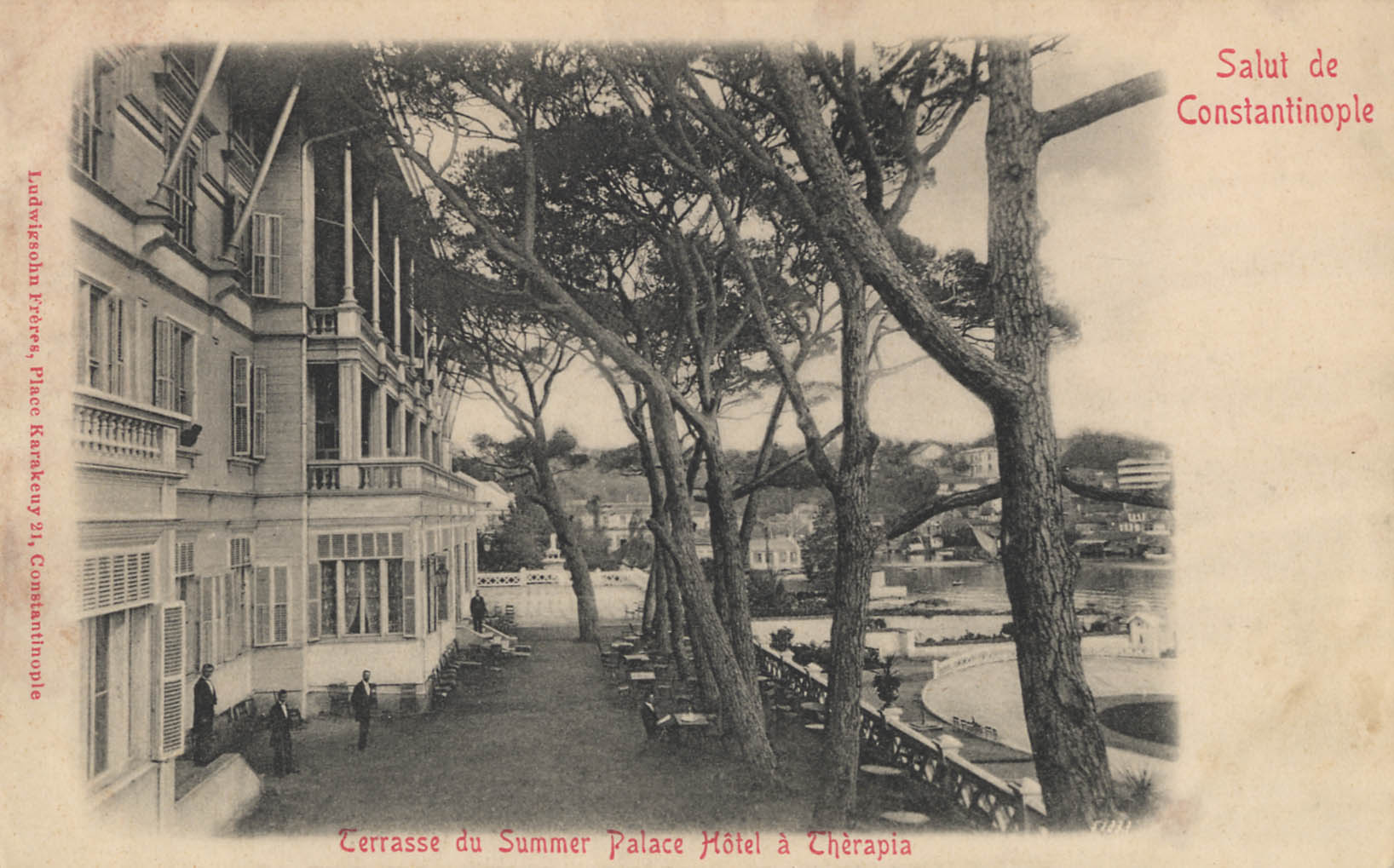Archive
Studio Clemens Holzmeister
- Studio Clemens Holzmeister
- Studio
Between 1938 and 1947, the architect Clemens Holzmeister lived and worked in Istanbul Tarabya at Sümer Otel, formerly the Summer Palace Hotel.
Word Count: 21
Sümer Otel (old Summer Palace Hotel), Tarabya, Istanbul (studio and residence).

Summer Palace Hotel à Thérapia. Salut de Constantinople, postcard, undated (SALT Research, https://archives.saltresearch.org/handle/123456789/107300). 
Ludwigsohn Frères, Terrasse du Summer Palace Hotel à Thérapia. Salut de Constantinople, postcard, undated (SALT Research, https://archives.saltresearch.org/handle/123456789/102619). Akçura, Gökhan. “Boğaziçi’nin ilk otelleri.” Milliyet, 29 March 2013, https://www.milliyet.com.tr/cadde/bogazici-nin-ilk-otelleri-1686922. Accessed 3 February 2021.
Balamir, Aydan, editor. Peyzaj ve Sahne Ressamı Clemens Holzmeister. Mimarın Türkiye de yaptığı Resimler (1940–1972). Architect as Scenery Painter: Clemens Holzmeister’s Landscape and Stage Paintings in Turkey (1940–1972). Şevki Vanlı Mimarlık Vakfı, 2011.
Dogramaci, Burcu. Kulturtransfer und nationale Identität. Deutschsprachige Architekten, Stadtplaner und Bildhauer in der Türkei nach 1927. Gebr. Mann, 2008.
Erdem, Ümit Baki. “Mıgırdiç Tokatliyan, Tokatliyan otelleri, gazinosu ve lokantasi. Cumhurbaşkanlığı Osmanlı Arşivi Belgelerine Göre.” MANAS Sosyal Araştırmalar Dergisi, vol. 8, no. 1, 2019, pp. 1367–1390. DergiPark Akademik, https://dergipark.org.tr/tr/download/article-file/655062. Accessed 2 February 2021.
Flierl, Thomas. “Mit einem Karton voller Briefe auf Zeitreise.” Schütte-Lihotzky, Margarete, and Wilhelm Schütte. “Mach den Weg um Prinkipo, meine Gedanken werden Dich dabei begleiten!” Der Gefängnis-Briefwechsel 1941–1945, edited by Thomas Flierl, Lukas Verlag, 2021, pp. 409–576.
Herbert Eichholzer 1903–1943. Architektur und Widerstand, edited by Heimo Halbrainer, exh. cat. Clio, Graz, 1998.
Holzmeister, Clemens. Architekt in der Zeitenwende. Selbstbiographie, Werkverzeichnis. Das Bergland-Buch, 1976.
Nicolai, Bernd. Moderne und Exil. Deutschsprachige Architekten in der Türkei 1925–1955. Verlag für Bauwesen, 1998.
Nicolai, Bernd. “‘Zeichen geordneter Macht’ – Clemens Holzmeister und die Türkei.” Clemens Holzmeister, edited by Georg Rigele and Georg Loewit, exh. cat. RLB Kunstbrücke, Raiffeisen-Landesbank Tirol, Innsbruck, 2000, pp. 116–135.
Schmid, Lothar, and Bernhard Schmid, editors. In fernen Zonen – Karl Mays Weltreisen (Karl May’s gesammelte Werke, vol. 82), Karl-May-Verlag, 1999.
Yakartepe, Elif Çelebi, and Can Binan. “Istanbul’un Modernleşme Dönemi Otelleri (1840–1914).” Megaron, vol. 6, no. 2, 2011, pp. 79–94, https://jag.journalagent.com/megaron/pdfs/MEGARON_6_2_79_94.pdf. Accessed 4 February 2021.
Word Count: 264
- 1938
- 1947
- Istanbul
- Burcu Dogramaci. "Studio Clemens Holzmeister." METROMOD Archive, 2021, https://archive.metromod.net/viewer.p/69/2949/object/5145-11194371, last modified: 20-06-2021.
-
Eckert-Rifki VillaBuildingIstanbul
The architect Clemens Holzmeister designed the Eckert-Rifki Villa in Baltalimanı on the shores of the Bosporus in 1943/44. The residence has a tiled roof, bay windows and a stone base.
Word Count: 29
Pera Palace HotelHotelIstanbulThe Pera Palace was the gem of Pera district where people gathered to wine and dine and be entertained, as well as to discuss the issues of the day.
Word Count: 29
Margarete Schütte-Lihotzky and Wilhelm Schütte ApartmentResidenceIstanbulThe exiled architects Margarete Schütte-Lihotzky and Wilhelm Schütte lived from 1938 in an apartment in Kabataş, on the European side of Istanbul. The flat has been preserved in numerous photographs, allowing the interior design to be reconstructed. The view of the Bosporus from the balcony was spectacular.
Word Count: 48
Festive architecture for the 15th anniversary of the Turkish RepublicTemporary street architectureIstanbulOne of the first commissions of the architects Margarete Schütte-Lihotzky and Wilhelm Schütte, who emigrated to Istanbul in 1938, was a street architecture for the anniversary of the Turkish Republic.
Word Count: 31
Gustav OelsnerArchitectCity PlannerIstanbulGustav Oelsner became the founding father of urban planning in Turkey, his country of exile. He was also the author of numerous articles for the architectural journal Arkitekt.
Word Count: 28